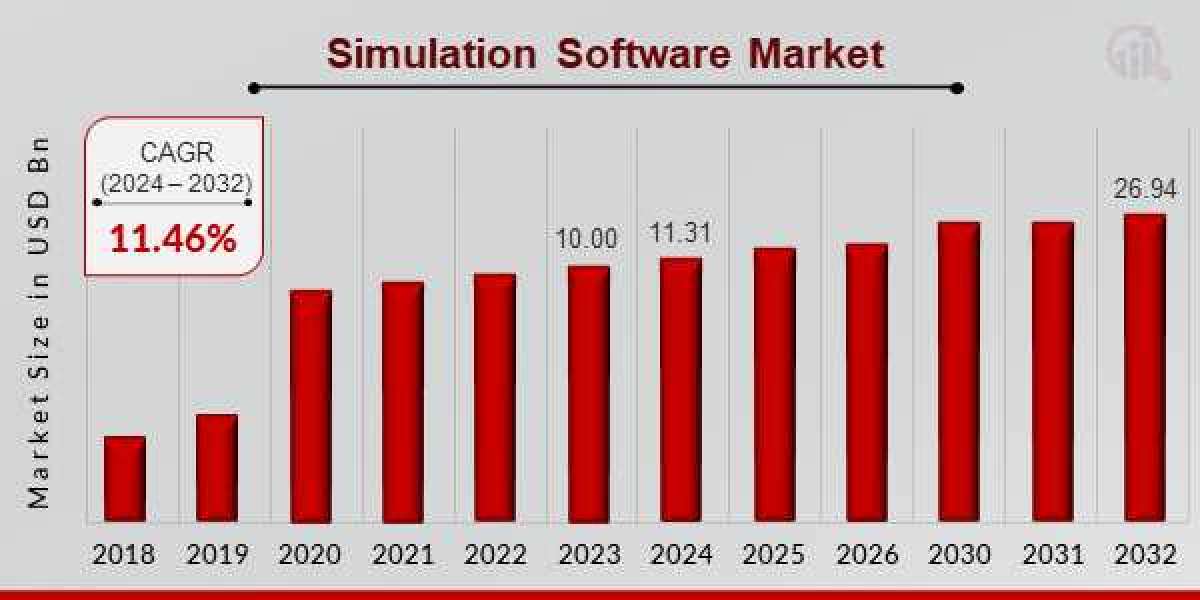Simulation Software Market Overview
The simulation software market is a rapidly growing segment within the broader software industry, driven by the increasing need for risk-free testing environments, enhanced design capabilities, and cost-effective training solutions. Simulation software allows businesses and organizations to create detailed, realistic models of systems, processes, or products to analyze their performance under various conditions without the need for physical prototypes. This capability is particularly valuable in industries such as aerospace, automotive, healthcare, defense, and manufacturing, where precision and reliability are paramount. Simulation Software Market size is projected to grow from USD 11.31 Billion in 2024 to USD 26.94 Billion by 2032, exhibiting a compound annual growth rate (CAGR) of 11.46% during the forecast period (2023 - 2032).
The market's growth is fueled by advancements in technology, including improvements in computing power, the rise of artificial intelligence (AI) and machine learning (ML), and the integration of the Internet of Things (IoT). These technological innovations are expanding the capabilities of simulation software, making it more accessible and practical for a wide range of applications.
Request To Free Sample of This Strategic Report - https://www.marketresearchfuture.com/sample_request/5769
Key Market Segments
Software Type
- Finite Element Analysis (FEA): Used for structural analysis and durability testing in industries like automotive and aerospace.
- Computational Fluid Dynamics (CFD): Focuses on fluid flow and heat transfer simulations, essential for aerospace, automotive, and chemical engineering.
- Electromagnetic (EM) Simulation: Utilized in designing and testing electromagnetic systems, crucial for electronics and telecommunication.
- Multibody Dynamics (MBD): Simulates mechanical systems composed of interconnected bodies, important for automotive and machinery sectors.
Deployment Mode
- On-Premise: Traditional deployment offering greater control and security, preferred by industries with sensitive data.
- Cloud-Based: Growing in popularity due to its scalability, flexibility, and lower upfront costs, suitable for businesses of all sizes.
End-Use Industry
- Aerospace Defense: For testing and optimizing complex systems and components.
- Automotive: To enhance vehicle design, safety, and performance.
- Healthcare: For medical device testing and procedural training.
- Manufacturing: To improve process efficiency and product quality.
- Energy Utilities: For optimizing energy production and distribution systems.
Geography
- North America: A leading region due to the presence of major technology companies and high adoption rates of advanced simulation tools.
- Europe: Significant growth driven by automotive and aerospace industries, particularly in Germany and the UK.
- Asia-Pacific: Rapid expansion fueled by industrialization, especially in China, Japan, and South Korea.
- Latin America and Middle East Africa: Emerging markets with increasing adoption of simulation technologies in manufacturing and energy sectors.
Industry Latest News
Recent developments in the simulation software market highlight the sector's dynamic nature and the continuous advancements driving its growth:
- January 2024: ANSYS released ANSYS 2024 R1, featuring enhanced AI capabilities and improved user interface, aimed at accelerating simulation processes.
- November 2023: Siemens Digital Industries Software launched a new version of Simcenter, integrating advanced CFD tools for better aerodynamics simulations.
- September 2023: Altair acquired newMachine, a startup specializing in AI-driven simulation tools, to enhance its product offerings.
- July 2023: Dassault Systèmes introduced SIMULIA 2024, with expanded cloud-based functionalities and better integration with IoT platforms.
- May 2023: Autodesk announced the acquisition of Upchain, aiming to streamline product lifecycle management (PLM) and simulation software integration.
These updates reflect the market's commitment to innovation and the adoption of cutting-edge technologies to meet evolving industry needs.
Key Companies
The simulation software market is highly competitive, with several key players leading the way in innovation and market share:
- ANSYS: Known for its comprehensive suite of simulation tools, including FEA, CFD, and EM simulation software, ANSYS is a market leader with a strong presence across various industries.
- Siemens Digital Industries Software: Offers the Simcenter portfolio, integrating simulation and testing solutions for product design and performance optimization.
- Dassault Systèmes: Provides the SIMULIA brand of simulation applications, known for their advanced capabilities in structural, fluid, and electromagnetic simulations.
- Autodesk: Known for its user-friendly simulation software integrated with its CAD tools, catering primarily to the design and manufacturing sectors.
- Altair Engineering: Offers a broad range of simulation tools, including its flagship product HyperWorks, which encompasses structural, fluid, and electromagnetic simulations.
These companies are at the forefront of the market, continually enhancing their product offerings to stay ahead of technological advancements and customer demands.
Market Drivers
Several key factors are driving the growth of the simulation software market:
- Technological Advancements: Continuous improvements in computing power, AI, ML, and IoT integration are expanding the capabilities and applications of simulation software.
- Cost Efficiency: Simulation software reduces the need for physical prototypes and testing, significantly lowering development costs and time.
- Enhanced Product Development: The ability to test and optimize designs in a virtual environment leads to better-performing, more reliable products.
- Risk Mitigation: Simulation allows for the identification and resolution of potential issues before they occur in the real world, enhancing safety and reliability.
- Regulatory Compliance: Many industries use simulation software to ensure their products meet stringent regulatory standards, particularly in aerospace, automotive, and healthcare sectors.
Ask for Customization - https://www.marketresearchfuture.com/ask_for_customize/5769
Regional Insights
The simulation software market exhibits significant regional variations, influenced by industrial activity, technological adoption, and economic conditions:
- North America: Dominates the market due to its strong technological infrastructure, presence of major industry players, and high investment in RD. The region's focus on innovation and early adoption of advanced technologies propels market growth.
- Europe: Home to leading automotive and aerospace industries, Europe shows substantial demand for simulation software. Countries like Germany, the UK, and France are key markets due to their robust manufacturing and engineering sectors.
- Asia-Pacific: The fastest-growing market, driven by rapid industrialization, increasing manufacturing activities, and rising investments in technology. China, Japan, and South Korea are leading contributors to the region's growth.
- Latin America and Middle East Africa: Emerging markets with growing industrial sectors and increasing adoption of advanced technologies. These regions offer significant growth potential as they continue to modernize their industries and infrastructure.
Conclusion
The simulation software market is poised for sustained growth, driven by technological advancements, cost efficiency, and the need for enhanced product development and risk mitigation. Key players are continuously innovating to meet the evolving demands of various industries. As technology continues to advance and industries increasingly recognize the value of simulation, the market for simulation software will expand, offering numerous opportunities for growth and development. The future of this market lies in the seamless integration of AI, ML, and IoT, ensuring that simulation software remains a crucial tool for innovation and efficiency across all sectors.
Simulation Software Market Highlights:



